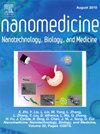Nanoparticles may influence mast cells gene expression profiles without affecting their degranulation function
IF 4.6
2区 医学
Q2 MEDICINE, RESEARCH & EXPERIMENTAL
Nanomedicine : nanotechnology, biology, and medicine
Pub Date : 2025-04-02
DOI:10.1016/j.nano.2025.102818
引用次数: 0
Abstract
An in vitro method for monitoring nanoparticle effects on IgE-dependent mast cell degranulation was developed and validated. The assayed nanoparticles included four clinical-grade nanomedicines (Abraxane, Doxil, AmBisome, and Feraheme) and three commercial research-grade nanomaterials (generation 5 PAMAM dendrimers with carboxy-, hydroxy-, or amine- surface functionalities). Most of the tested materials did not alter IgE-dependent mast cell degranulation, suggesting that nanoparticles and nanomedicines are unlikely to worsen pre-existing allergies to other antigens. Two clinical-grade formulations containing cytotoxic oncology drugs—Abraxane and Doxil—decreased degranulation. Abraxane but not Doxil decreased FcεR expression on the cell surface. Single-cell sequencing revealed the most differentially expressed genes (DEG) in Abraxane and Doxil-treated cultures. Interestingly, Feraheme and amine-terminated dendrimers induced DEG without affecting degranulation. These data demonstrate that some nanomaterials have more effects on immune cells than can be detected by a functional immunoassay.

纳米颗粒可能影响肥大细胞基因表达谱而不影响其脱颗粒功能。
建立并验证了一种监测纳米颗粒对ige依赖性肥大细胞脱颗粒影响的体外方法。检测的纳米颗粒包括四种临床级纳米药物(Abraxane, Doxil, AmBisome和Feraheme)和三种商业研究级纳米材料(第5代具有羧基,羟基或胺表面功能的PAMAM树状大分子)。大多数被测试的材料不会改变ige依赖性肥大细胞脱颗粒,这表明纳米颗粒和纳米药物不太可能恶化对其他抗原已有的过敏。两种临床级配方含有细胞毒性肿瘤药物- abraxane和doxil -减少脱颗粒。Abraxane降低了细胞表面fc - ε r的表达,而Doxil没有降低。单细胞测序显示,Abraxane和doxil处理的培养物中差异表达最多的基因(DEG)。有趣的是,Feraheme诱导DEG而不影响脱颗粒。这些数据表明,一些纳米材料对免疫细胞的影响比功能性免疫测定法所能检测到的更大。
本文章由计算机程序翻译,如有差异,请以英文原文为准。
求助全文
约1分钟内获得全文
求助全文
来源期刊
CiteScore
11.10
自引率
0.00%
发文量
133
审稿时长
42 days
期刊介绍:
The mission of Nanomedicine: Nanotechnology, Biology, and Medicine (Nanomedicine: NBM) is to promote the emerging interdisciplinary field of nanomedicine.
Nanomedicine: NBM is an international, peer-reviewed journal presenting novel, significant, and interdisciplinary theoretical and experimental results related to nanoscience and nanotechnology in the life and health sciences. Content includes basic, translational, and clinical research addressing diagnosis, treatment, monitoring, prediction, and prevention of diseases.

 求助内容:
求助内容: 应助结果提醒方式:
应助结果提醒方式:


